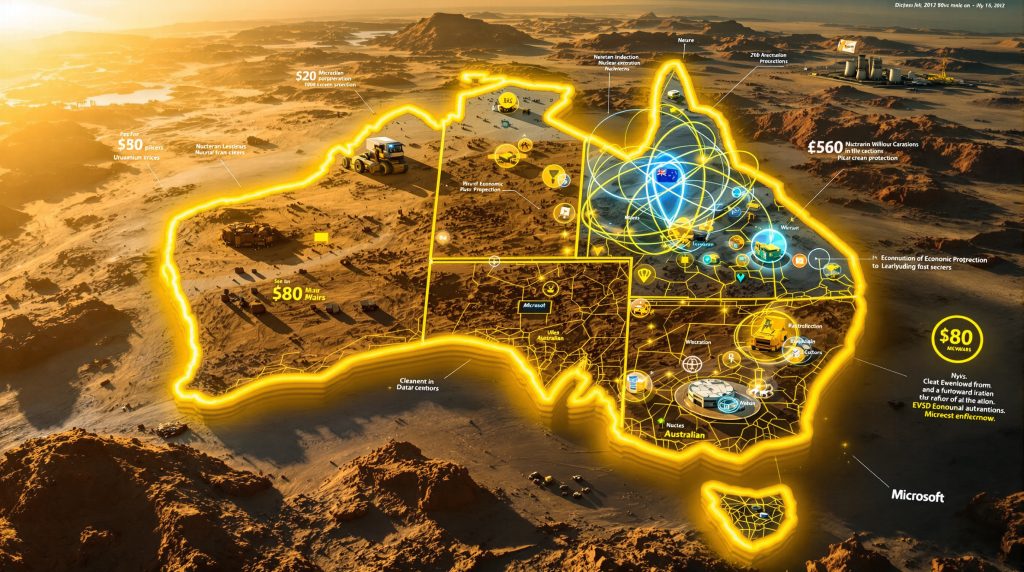Western Australia Uranium Mining Ban: Economic and Political Analysis
Western Australia's uranium mining prohibition represents one of the most significant regulatory barriers in Australia's resource sector. Implemented in 2017 by the McGowan Labor government, the ban effectively froze development of several advanced uranium projects that had received environmental approvals under the previous Liberal administration. While exploration activities remain permitted, the prohibition prevents any actual mining operations, creating a unique situation where companies can discover and define resources but cannot extract them.
What is Western Australia's current uranium policy?
The current policy prohibits the granting of new uranium mining leases while allowing continued exploration. This creates a regulatory environment where companies can maintain and expand their resource base but cannot proceed to production. The policy includes a grandfather clause that permitted projects with existing approvals to proceed if they could demonstrate "substantial commencement" before a specified deadline.
Most mining companies have been forced into a holding pattern, investing minimally to maintain their assets while awaiting potential policy shifts. This regulatory limbo has effectively sidelined Western Australia from participation in the global uranium market despite the state's significant resource potential.
How does the ban impact Western Australia's economy?
Western Australia holds approximately 226,000 tonnes of uranium resources, representing significant untapped economic potential. With uranium prices climbing steadily in recent years, the economic opportunity cost has grown substantially. Industry analysts estimate the prohibition prevents billions in potential investment, hundreds of direct jobs, and substantial royalty revenues.
The ban creates particular challenges for remote communities where uranium projects could provide significant employment and business opportunities. Indigenous communities near proposed uranium developments have expressed varied perspectives, with some supporting development for economic benefits while others maintain environmental concerns.
Political Dynamics Driving Policy Reconsideration
Recent signals from Western Australia's government indicate a potential shift in uranium mining policy. Premier Roger Cook has publicly acknowledged ongoing discussions with the uranium industry, representing an unprecedented opening in the government's position since implementing the ban.
Why is the WA government reconsidering its position now?
Premier Cook's public acknowledgment of ongoing uranium policy discussions marks a significant shift in the government's stance. This evolution appears driven by several factors:
- Economic pressure: Rising uranium prices have increased the opportunity cost of maintaining the ban
- Strategic timing: The parliamentary review process aligns with mid-term policy adjustments ahead of the next state election
- Shifting voter sentiment: Recent polling shows 49% of Western Australians now support uranium mining while only 16% oppose it
- Federal policy contradictions: The approval of nuclear submarines and associated infrastructure highlights inconsistencies in nuclear policy
The timing of these discussions suggests calculated political strategy. When the uranium mining halt in Namibia was announced, it highlighted the shifting global supply dynamics that are affecting policy considerations. With prices now much stronger due to uranium market volatility, the economic case for maintaining the ban has substantially weakened.
What parliamentary mechanisms could facilitate policy change?
The current parliamentary inquiry into global decarbonization and Western Australia's export opportunities provides a structured pathway for policy revision. While uranium is not explicitly mentioned in the terms of reference, the acceptance of uranium-focused submissions indicates the scope includes nuclear fuel considerations. The inquiry's timeline, with final recommendations due by September 2026, creates a strategic window for policy adjustment that avoids direct electoral implications.
This approach allows the government to frame any policy changes as responding to expert recommendations rather than reversing a previous position. The inquiry structure also provides multiple stakeholders opportunities to present evidence supporting policy revision, building a comprehensive case for change.
International Context and Market Fundamentals
The global context for uranium has shifted dramatically in recent years, creating additional pressure for policy reconsideration. Nuclear energy's role in decarbonization efforts has gained increasing recognition, with many countries expanding their nuclear fleets or considering new deployments.
How does global nuclear growth impact Western Australian policy?
The global nuclear sector has experienced significant expansion, with recent years marking record levels of nuclear generation globally. Major economies including China, India, the United Kingdom, and the United States are expanding their nuclear fleets, creating sustained demand growth for uranium. The recent US uranium import ban on Russian materials has further emphasized the need for secure supply from allied nations.
These supply-demand dynamics have supported uranium price strength, increasing the opportunity cost of Western Australia's mining prohibition. The widening gap between global uranium demand and available supply sources creates potential market opportunities that Western Australian projects could address if permitted to develop.
What role do technology companies play in nuclear demand?
Major technology corporations have emerged as significant advocates for nuclear energy, driven by growing data center power requirements and artificial intelligence deployment. Microsoft's membership in the World Nuclear Association signals serious corporate commitment to nuclear power as a reliable, carbon-free energy source. This corporate engagement potentially accelerates nuclear deployment timelines and creates additional uranium demand that traditional forecasts may not fully capture.
The technology sector's entrance into nuclear energy discussions brings new perspectives and potentially faster decision-making compared to traditional utilities. These companies operate on different timelines and with different priorities, potentially accelerating nuclear deployment and uranium demand growth beyond conventional projections.
Technical and Operational Considerations
Uranium mining presents significant technical challenges regardless of regulatory environments. Recent industry experiences highlight the importance of operational expertise and realistic development expectations.
What challenges do uranium mining projects face?
Recent operational difficulties at Boss Energy's Honeymoon in-situ recovery (ISR) project in South Australia highlight the technical complexities of uranium mining. The project experienced production issues that resulted in significant market capitalization losses, demonstrating that even established technologies like US uranium ISR technology require experienced personnel and careful implementation. These challenges reinforce the importance of technical expertise and realistic development timelines.
The industry has historically faced challenges bringing new production online, with projects frequently experiencing delays and technical difficulties. These realities suggest that even with policy changes, Western Australian projects would require careful planning and implementation to achieve successful operations.
How are companies preparing for potential policy changes?
Companies with Western Australian uranium resources are pursuing strategic partnerships to enhance their technical capabilities and project readiness. Cauldron Energy's cooperation agreement with Navoiyuran, Uzbekistan's national uranium company, provides access to extensive ISR expertise across 42 different uranium fields. This relationship demonstrates international confidence in Western Australian uranium potential while addressing technical implementation risks.
Other companies maintain their resource positions through minimal-cost exploration activities, allowing continued definition of resources while awaiting potential policy changes. These strategies balance financial constraints with maintaining development optionality, positioning companies to respond quickly if mining restrictions are lifted.
Economic and Resource Potential
Western Australia's uranium resources represent significant economic potential if mining restrictions are lifted. The state hosts several world-class deposits with grades comparable to operating mines in other jurisdictions, according to the Geological Survey of Western Australia.
What uranium resources does Western Australia hold?
Western Australia contains several significant uranium deposits, including:
| Project | Company | Resource Size | Grade | Status |
|---|---|---|---|---|
| Mulga Rock | Deep Yellow | 71.2 Mlbs U₃O₈ | 570 ppm | Approved (substantial commencement achieved) |
| Yeelirrie | Cameco | 128 Mlbs U₃O₈ | 1,500 ppm | Approved (on hold) |
| Wiluna | Toro Energy | 62.7 Mlbs U₃O₈ | 520 ppm | Approved (on hold) |
| Kintyre | Cameco | 55 Mlbs U₃O₈ | 550 ppm | Approved (on hold) |
| Lake Maitland | Toro Energy | 23.9 Mlbs U₃O₈ | 530 ppm | Exploration |
These resources represent substantial economic potential if mining restrictions are lifted, with grades comparable to or exceeding those of currently operating mines in other jurisdictions.
What economic benefits could uranium mining deliver?
Industry assessments suggest uranium mining could generate:
- 500-1,000 direct construction jobs per major project
- 200-400 ongoing operational positions per mine
- $100-200 million in annual export value per operating mine
- $15-30 million in annual royalty payments to the state government
- Significant indigenous employment and business opportunities in remote regions
These economic benefits would be particularly significant in remote regions where alternative employment opportunities are limited. The royalty payments would provide additional government revenue for essential services and infrastructure development.
Environmental and Community Considerations
Environmental and community perspectives remain central to uranium policy discussions. While concerns exist, sentiment appears to be shifting as climate considerations and modern mining practices influence the conversation.
How have environmental concerns influenced the uranium debate?
Environmental considerations have been central to Western Australia's uranium mining prohibition. Concerns include potential groundwater impacts, radioactive waste management, and broader questions about nuclear energy's role in the energy transition. However, modern uranium mining practices incorporate extensive environmental safeguards, and the industry argues that nuclear power's carbon-free generation profile creates net environmental benefits through global emissions reduction.
Environmental review processes for Western Australian uranium projects have established comprehensive management requirements for any future operations. These requirements would ensure stringent controls on environmental impacts if projects were permitted to proceed.
What is the current community sentiment toward uranium mining?
Community perspectives have evolved significantly since the ban's implementation. Recent polling indicates growing support for uranium mining, with 49% of Western Australians now favoring development. This shift reflects broader acceptance of nuclear energy's role in addressing climate change and greater understanding of modern mining practices. Indigenous communities near potential projects have expressed varied perspectives, with some supporting development for economic opportunities while others maintain concerns.
The increasing recognition of climate challenges has influenced public perspectives on nuclear energy and uranium mining. As emissions reduction becomes a higher priority, the carbon-free nature of nuclear power has gained greater recognition, influencing community attitudes toward the uranium supply chain.
Future Outlook and Policy Scenarios
The path forward for Western Australian uranium mining depends on political decisions, market conditions, and project readiness. Several potential scenarios emerge from current dynamics.
What is the most likely timeline for policy revision?
Based on current political dynamics and the parliamentary inquiry schedule, industry analysts anticipate potential policy changes by late 2026. This timeline allows for:
- Completion of the parliamentary inquiry (September 2026)
- Government response period (3-6 months)
- Implementation of any policy changes (early 2027)
- Project restart and development activities (12-24 months)
- First potential production from Western Australian uranium mines (2029-2030)
This timeline aligns with political considerations, allowing policy implementation before the next state election while providing sufficient time for the government to frame the changes as responding to inquiry recommendations rather than reversing previous positions.
How would policy changes affect uranium market dynamics?
While Western Australian projects would add significant uranium resources to the global supply pipeline, development timelines mean production would likely begin in the late 2020s or early 2030s. This aligns with projected supply deficits in the uranium market, potentially helping to address long-term supply constraints without creating near-term oversupply conditions.
The market impact would depend significantly on which projects advance first and their development timelines. Projects with existing approvals would likely advance most quickly, while others would require new permitting processes before development could commence. Investors considering uranium investment strategies should carefully monitor Western Australia's policy developments.
FAQ: Western Australia Uranium Mining Policy
When might Western Australia lift its uranium mining ban?
Based on the parliamentary inquiry timeline and political considerations, policy changes could occur by late 2026, allowing implementation before the next state election.
Which uranium projects could advance first if the ban is lifted?
Projects with existing environmental approvals, particularly Mulga Rock (which achieved substantial commencement status), would likely advance most quickly, followed by other approved projects including Wiluna, Kintyre, and Yeelirrie.
How does Western Australia's uranium policy affect Australia's climate commitments?
The policy creates a paradox where Australia exports uranium from other states while prohibiting development in Western Australia, potentially limiting nuclear energy's contribution to global emissions reduction despite Australia's climate commitments.
What indigenous considerations apply to uranium development?
Many uranium resources are located on or near traditional lands, requiring comprehensive consultation and agreement-making with Traditional Owners. Several projects have established indigenous agreements, though these relationships require ongoing maintenance during the policy prohibition period.
How do technical challenges affect development timelines?
Recent operational difficulties at existing uranium projects highlight the importance of technical expertise and realistic development schedules. Even with policy changes, projects would likely require 2-4 years of development before production.
Further Exploration
Readers interested in learning more about Australia's uranium mining policies and nuclear energy considerations can explore related educational content available from the Chamber of Commerce and Industry Western Australia, which provides industry perspectives on uranium development potential and regulatory frameworks.
For those interested in global uranium market dynamics, organizations like the World Nuclear Association offer comprehensive analyses of supply-demand trends and nuclear energy deployment projections that provide context for Western Australian policy discussions.
Want to Stay Ahead of the Next Major ASX Mineral Discovery?
Discovery Alert's proprietary Discovery IQ model instantly notifies investors of significant mineral discoveries on the ASX, including potential uranium opportunities if Western Australia's policy shifts. Visit our discoveries page to see how previous major discoveries have delivered exceptional returns and position yourself ahead of the market.




